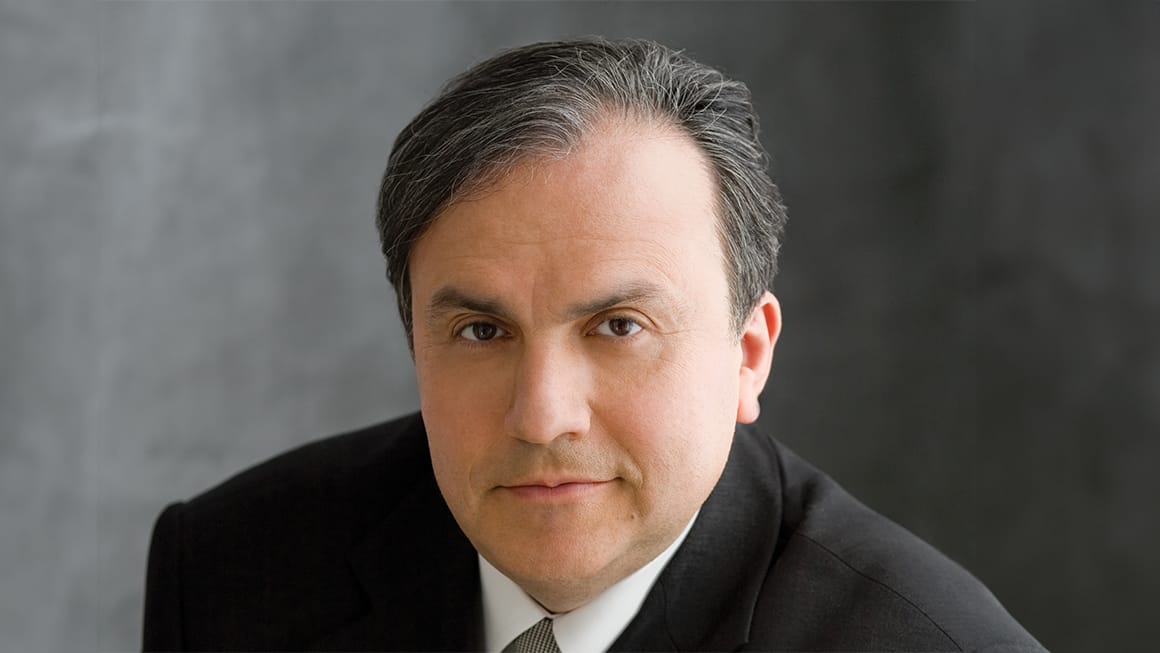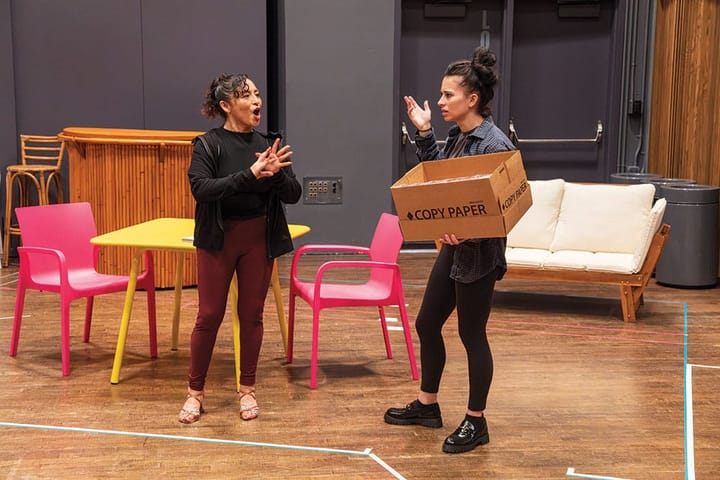Piano Series April 18 | 7:30 p.m.
Piano Series
YEFIM BRONFMAN
April 18 | 7:30 p.m.
FRANZ SCHUBERT
(1797–1828)
Piano Sonata No. 14 in A Minor, Op. 143
I. Allegro giusto
II. Andante
III. Allegro vivace
ROBERT SCHUMANN
(1810–1856)
Faschingsschwank aus Wien, Op. 26
I. Allegro, Sehr lebhaft
II. Romanze, Ziemlich langsam
III. Scherzino
IV. Intermezzo, Mit grösster Energie
V. Finale, Höchst lebhaft
INTERMISSION
ESA-PEKKA SALONEN
(b. 1958)
Sisar
FRÉDÉRIC CHOPIN
(1810–1849)
Piano Sonata No. 3 in B Minor, Op. 58
I. Allegro maestoso
II. Scherzo, Molto vivace
III. Largo
IV. Finale, Presto non tanto
SERGEI PROKOFIEV
(1891–1953)
Piano Sonata No. 7 in B-flat Major, Op. 83, “Stalingrad”
I. Allegro inquieto
II. Andante caloroso
III. Precipitato
Exclusive Management: Opus 3 Artists
Suite 282 | 348 West 57th Street | New York, NY 10019
Series Sponsors
generously underwritten by
Sven & Melinda Bitners and Sally Schaake Kincaid
SEASON SUPPORT COMES FROM
Microsoft
Artsfund
Nesholm Family Foundation
Horizons Foundation of Washington
Seattle Office of Arts and Culture
4Culture
MEDIA PARTNER
Classical KING FM 98.1
SIGNATURE SUPPORT
In Honor of Eric & Margaret Rothchild’s 65th Wedding Anniversary
ADDITIONAL SUPPORT COMES FROM
Barbara Billings & Ernest Vogel
Sylvia & Stephen Burges
Diana K. Carey
Heidi Charleson & Louis Woodworth
Carol & Carol Corbin
Katharyn Alvord Gerlich
Lynn & Brian Grant Family
M. Elizabeth Halloran
Matthew & Christina Krashan
Jeffrey Lehman & Katrina Russell
Hans & Kristin Mandt
Tom McQuaid Jr.
Rebecca Norton & Craig Miller
Seema Pareek & Gurdeep Pall
Richard and Sally Parks
Cheryl Redd-Cuthbert & Richard Cuthbert
Eric & Margaret Rothchild
Don & Toni Rupchock
Sally Schaake Kincaid
Maya Sonenberg & John Robinson
Dave & Marcie Stone
Don & Gloria Swisher
Barbara Billings & Ernest Vogel
Jeff & Carol Waymack

About the Artist
Internationally recognized as one of today’s most acclaimed and admired pianists, Yefim Bronfman stands among a handful of artists regularly sought by festivals, orchestras, conductors and recital series. His commanding technique, power and exceptional lyrical gifts are consistently acknowledged by the press and audiences alike.
Following summer festival appearances in Verbier, Israel, Aspen, Grand Tetons and Sun Valley the season begins with a European tour celebrating the auspicious 500th anniversary of the Munich Opera and Orchestra with concerts in Lucerne, Bucharest, London, Paris, Linz, Vienna and Munich. In partnership with Amsterdam’s Royal Concertgebouw Orchestra together they will visit Japan and Korea followed in the US by return engagements throughout the season with New York Philharmonic, Boston, Kansas City, National, Milwaukee, Pittsburgh, San Francisco symphonies and Minnesota Orchestra. With Munich Philharmonic and both Brahms concerti on the program he will travel to Spain and Carnegie Hall followed by European engagements with Budapest Festival Orchestra. An extensive winter/spring recital tour will begin in Ljubljana and include Milan, Berlin, Cleveland, Chicago, Vancouver, Seattle, San Francisco, Los Angeles, La Jolla and culminate in Carnegie Hall in early May.
Born in Tashkent in the Soviet Union, Yefim Bronfman immigrated to Israel with his family in 1973, where he studied with pianist Arie Vardi, head of the Rubin Academy of Music at Tel Aviv University. In the United States, he studied at The Juilliard School, Marlboro School of Music, and the Curtis Institute of Music, under Rudolf Firkusny, Leon Fleisher, and Rudolf Serkin. A recipient of the prestigious Avery Fisher Prize, one of the highest honors given to American instrumentalists, in 2010 he was further honored as the recipient of the Jean Gimbel Lane prize in piano performance from Northwestern University and in 2015 with an honorary doctorate from the Manhattan School of Music.
About the Program
Piano Sonata in A Minor, Op. 143, D. 784 (1823)
FRANZ SCHUBERT
During a large part of the 19th century, the piano sonata did not have the place in concert life that it now holds. Today recital-goers think of a sonata as a big and generally weighty composition consisting of large and independent movements sometimes bound together by a musical device or by sentiment and spirit; a sonata is a work that keeps an audience’s attention for a relatively long period of time.
Schubert certainly wrote his piano sonatas only for private hearing; due to his poverty and lack of connections, he had no access to public venues. He was, he once said, “an admirer and worshipper” of Beethoven and wanted to try his hand at almost everything for which there was a model in the older man’s work. Schubert’s sonatas, however, did not find their proper place in the concert repertoire as easily as Beethoven’s had done. Ideas about musical form changed rapidly and radically during the 19th century, and Schubert’s sonatas were either thought too free or not free enough. Because they puzzled musicians, they were simply dropped. It was not until the centennial year of 1928 that Schubert’s sonatas were thoroughly reconsidered and began to be widely performed and loved.
Schubert wrote this piano sonata in February 1823; it was the first he had written in three and a half years. In the interval, Beethoven had published three of his late sonatas, which revealed an entirely new kind of piano music. Schubert, in this sonata, does not challenge Beethoven’s choices in size or scope, but he, too, demonstrates that he is seeking original powers of expression from the piano with a new seriousness of purpose. His painstakingly revised manuscript shows that this composition was not casually undertaken, and the result is an extraordinarily concise work that carries an intensely dramatic message.
This period in his young life was marked by his early maturity. He had written the Wanderer Fantasy in November, but in this sonata, composed only three months later, he shows no interest in the demonstration of the kind of virtuosity that the Fantasy demands. Instead, he requires the pianist to produce a great range of almost orchestral colors from the keyboard. This sonata marks a substantial advance in his technique. It has a dark Romantic tone and a dynamic drive that his piano sonatas never had had before.
Musicologists feel that Schubert’s illness at this time accounts, possibly, for the cosmic despair that some of his work from this period displays but, given the extroverted style and youthful spirit of the Wanderer Fantasy, this hypothesis may be questionable. In any case, in just the month when this work was composed, Schubert experienced the onset of serious illness. Although his 19th century biographers perhaps tactfully did not address the issue, various 20th century biographers did comment on the diagnosis of syphilis. The only treatment available was mercury, whose poisonous effects could be as difficult as the disease itself. In any case, in a letter in February 1823, Schubert explained his illness “did not permit him to leave the house” and he implied that he had already been ill for some time. After that, he disappeared from public view until the end of July.
In this work, the dramatic and lyrical parts balance each other. In the vast first movement of this highly concentrated composition in three movements, Allegro giusto, the themes are built of short motives added together to form long melodies that seem to be combined under pressure into a dense, compact musical structure of elemental power. Bryan Neubold, commenting that the first movement “is not pianistic in an obvious way,” suggests that it delivers a new approach to the idea of “timing” in the sense that the timing embraces tempo, rhythm, motion and repose. For that reason, he says that this movement is the most difficult of Schubert’s piano movements to interpret. The second movement, Andante, looks back to Beethoven and forward to Chopin. It is a nocturnal reverie interrupted by a powerful, dramatic outburst that subsides and then breaks out again in a single chord here and there. This movement delivers an outer peace with an undercurrent of disruptive emotion, which would later be more prominent in Schubert’s work. The brilliant finale, Allegro vivace, has a scherzo-like main theme and lyrical episodes; additionally, it mixes the contrapuntal style of a Bach invention, the full smashing chords of a Beethoven sonata and an innocent waltz-tune, in a manner that is Schubert’s alone. This movement of alternating incandescence and lyricism closes with a virtuoso section that demonstrates the pianist’s agility in rapid octaves.
Faschingsschwank aus Wien (Carnival Scenes from Vienna), Op. 26 (1839)
ROBERT SCHUMANN
Schumann went to Vienna for an extended stay in September 1838. Clara Wieck, the daughter of his piano teacher, had recently given very successful concerts there, and the two, who were in love, thought that if Schumann could move the magazine he edited from Leipzig to Vienna, they might move there and thus improve both his financial and artistic situation enough to gain Clara’s father’s approval. After six months, that plan did not work out, and Schumann left Vienna, but while he was there, he composed several short works as well as this brilliant extended cycle, which would not be performed publicly until after his death, when Clara herself premiered it.
Schumann subjected most of his compositions to intensive and protracted revision. He often gave them their picturesque titles well after they were conceived and written, and frequently, he wrote many coded messages into his music, some obvious and some cryptic. On March 15, 1839, a month after Carnival that year, the composer wrote to a wealthy Belgian admirer of his music (to whom he later dedicated this work) that it was a “grand romantic sonata.” The Intermezzo, the fourth of the piece’s five movements, was a later addition, and when Schumann first published it separately in his own magazine as a supplement, he said that it was one of his forthcoming Nachtstücke, or Nocturnes, Op. 23, but it evolved into a tribute to the Mardi Gras celebration with its complex revelry that included music, drama, mime, masquerade and dance.
At one point in the first movement of this work in which Schumann presents visions of spirited carnival revelry, he quotes the Marseillaise, its martial duple meter transformed into the triple meter of a Viennese waltz. Some critics feel that this might be a clue to the title; scholars have often said that the composer put the musical reference in simply because it was forbidden in the Austrian Empire, as it was considered a French revolutionary song. What Schumann might have had in mind, however, was the transmission of a musical message from Vienna to Paris, where Clara had gone in January, trying to build her career on her own, independent of her influential father who disapproved strongly of her match with Schumann.
By 1840, the year he and Clara married, Schumann gave the work its sonata-like form but with the first and last movements reversed. The first movement is headed with the word Allegro as a title rather than a tempo, which is given in German as Sehr lebhaft, or “Very lively.” This technically demanding movement begins with a waltz melody which, rondo-like, then alternates with contrasting and varied ideas. These episodes contrast from the lyrical to the Marseillaise Waltz. There are altogether five contrasting episodes. The last is related to the slow movement of Beethoven’s Sonata in E-flat Major, Op. 31, No. 3.
Next come two movements built of short motives, a brief, gentle, melancholy, but lyrical Romanze, Ziemlich langsam (“Rather slow”) with a flowery melodic theme and a little ebullient Scherzino that is a witty but abbreviated scherzo without a trio, a gay contrast to the second movement. An impassioned Intermezzo, Mit grösster Energie (“With very great energy”) follows with a soaring theme, and in the exuberant Finale, Höchst lebhaft, (“With the highest level of liveliness”) Schumann turns to the conventional sonata-allegro form with an added coda. This glorious but technically demanding concluding movement has a triumphant and energetic feel that ends with massive, stunning chords.
Sisar (2012)
ESA-PEKKA SALONEN
Sisar is the fifth and last piece in a series of short preludes for piano which I began almost ten years ago. Most of the pieces share material with larger projects from the same time; sometimes as testing ground for new ideas, sometimes as an afterthought, alternative reality.
Sisar belongs to the latter category. Its title has (at least) a double meaning: in Finnish sisar means sister, in Spanish to steal or filch. Both make sense: Sisar is the little sister of my orchestra piece Nyx (a mysterious and obscure goddess figure in Greek mythology), and it steals some of its material from the bigger relative.
The character of Sisar is capricious and dream-like with sudden bursts of kinetic energy interlaced with more static, calmer music. Sometimes characters and gestures mutate gradually into something new, sometimes a new identity is introduced suddenly, like a montage or an edit in a film. I have long been interested in juxtaposing the musical metaphors of organisms and mechanisms in my music. The six-minute Sisar plays with these ideas in a very concentrated form. Sisar is dedicated to Yefim Bronfman.
— Esa-Pekka Salonen
Sonata for Piano No. 3, in B Minor, Op. 58 (1844)
FRÉDÉRIC CHOPIN
Chopin only accepted the challenge of writing a sonata, a long work in several well-developed movements, four times. Between 1827 and 1846, a period that spans almost his entire career, he composed three piano sonatas and one for cello and piano. Piano Sonata No. 1, Chopin’s Op. 4, is little more than a student work, rarely played in public. Sonata No. 2, completed in 1839, owes its great popularity to its famous Funeral March.
Chopin wrote the Sonata No. 3 in 1844, during a happy summer he spent with George Sand at her country estate. The summer was a climactic time in the long liaison the two had had; it was a period when the composer was at the summit of his creative powers. The sonata was published the next year, dedicated to his friend Countess Emilie de Perthuis.
Sonata No. 3 is one of Chopin’s most profound works as well as the last sonata that he wrote for the piano. In the words of the musicologist Anatole Leikin, it is Chopin’s reconsideration “not only of sonata form, but of the sonata genre as well” because “his sonatas, like his mazurkas or nocturnes, are marked by a special musical idiom.” The Polish music historian, Tadeusz Zielinski, believes that his sonata is Chopin’s “deepest” work.
The musical ideas that Chopin uses here include melodic lines of consistently great beauty, but academic critics, for the most part, were often unwilling to take this sonata seriously, claiming a deficiency of analytic development in the work. The problems they found in the music, however, resulted from their own lack of flexibility, not any omissions of Chopin’s. For example, in the Allegro maestoso first movement, the critics were looking for a series of musical events in a preconceived order. The four-movement work begins with a heroic theme, followed by a second theme with a nocturnal mood. This grand movement provides a variety of musical ideas, with a uniquely Chopinesque melody central to it. Chopin uses more counterpoint here than in any other of his pieces, an indication of his veneration for Bach’s music, which he was known to have played daily.
Chopin, with the superior instincts of a great creative artist, combined the statement and development of his ideas in the first movement with such perfect fluency that the form of sonata allegro with its convention of recapitulation of the themes became superfluous for him. As a result, what Chopin did was quite radical: he omitted the subject altogether in the recapitulation. This musical decision may have stemmed from what he achieved in the development section where he so completely elaborated on the subject that he had no need to bring it back yet again in the recapitulation. Another of Chopin’s achievements is that he created extremely subtle thematic relationships among the various movements.
After the first movement, musicologists and historians found fewer reasons to scrutinize the sonata as closely or as critically. The second movement, a complete contrast, is a short Scherzo, Molto vivace, with shimmering right-hand figuration. There is a contrasting, but melodically related quiet central section. Tightly structured, the Scherzo is a light movement, allowing the listener to rest before the third movement, Largo, an elegiac nocturne in a similar three-part form. It seems like a radiant aria with the melodic material floating over the accompaniment. Charles Rosen, in his The Romantic Generation, lauded the third movement as an open homage to the Italian operatic stage. But Rosen does not find that Chopin shrugs off his own invention; Rosen also identifies Chopin’s “heterophonic counterpoint” in this movement where two voices play the same melody together in different rhythms.
The Finale, Presto non tanto, begins with a dramatic 16-chord fanfare. It is a brilliant and forceful movement in which the exultant opening theme recurs, with increasing intensity, as in a rondo, a structure that can be diagramed as ABABA. This well-developed movement has two main ideas, a complement to the thematic abundance of the first movement. The movement’s virtuosic coda brings the sonata to a magnificent and invigorating close.
© Susan Halpern 2024






